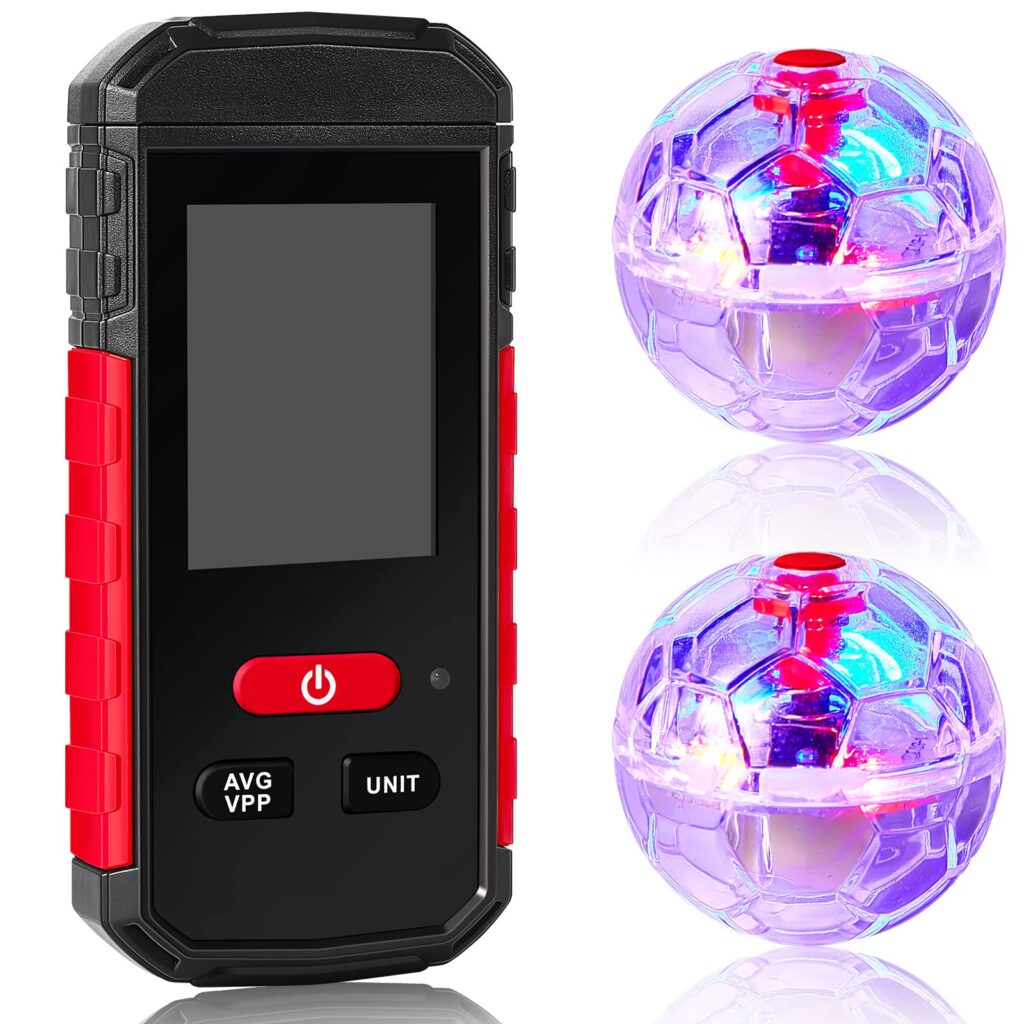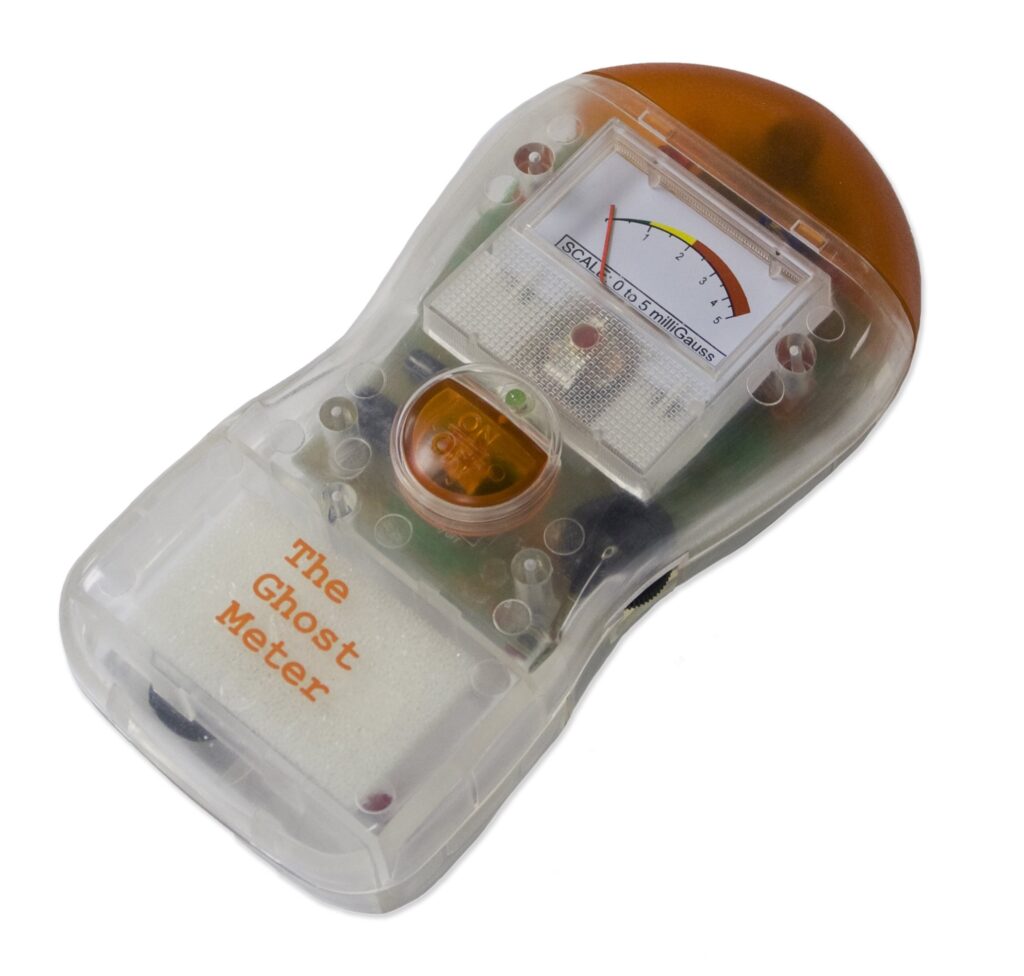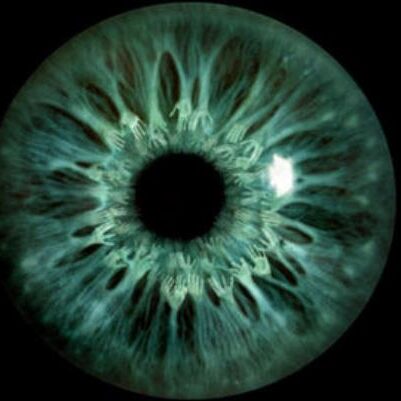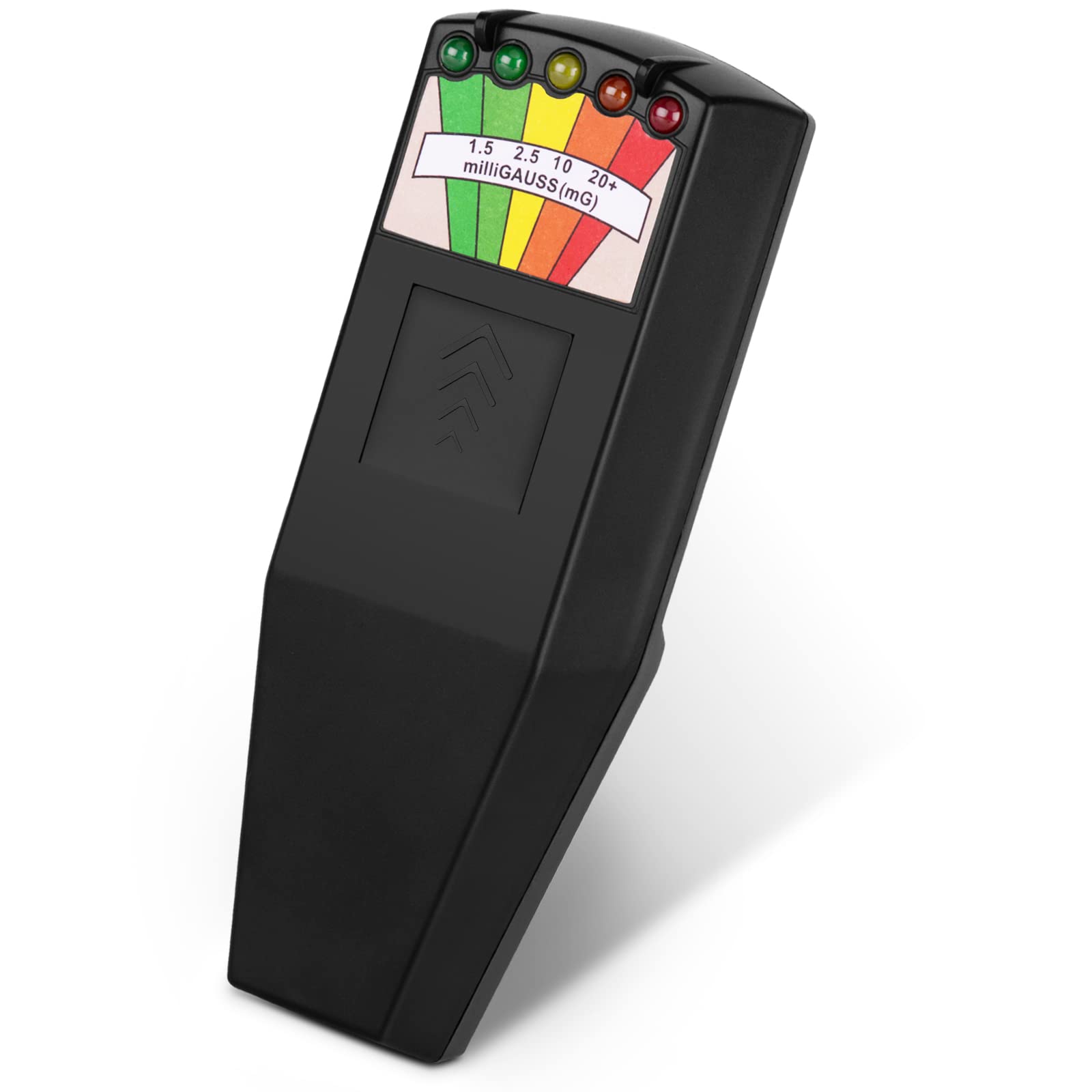Are you intrigued by the mysteries of the supernatural? Have you ever wanted to embark on a ghost hunting adventure? Well, look no further! In this article, we will explore the fascinating world of paranormal investigations using an EMF sensor. This incredible device has the power to detect electromagnetic field fluctuations, allowing you to uncover potential ghostly activity. Get ready to delve into the unknown and unlock the secrets of the paranormal realm with the help of an EMF sensor.
Click here to check out the Ghost Hunting Spirit Box – MEL-8704R & K2 EMF Meter & EVP Recorder
What is an EMF Sensor?
Definition
An EMF (Electromagnetic Field) sensor is a device designed to measure and detect electromagnetic radiation. It is commonly used in various fields, including paranormal investigations and ghost hunting, to detect and analyze changes in electromagnetic fields. EMF sensors are often handheld devices that provide real-time measurements and readings of electromagnetic radiation levels.
How does it work?
EMF sensors work on the principle that all electrical devices and living organisms emit electromagnetic fields. These fields can be measured using specialized sensors that are sensitive to the frequency and intensity of the electromagnetic radiation. When an EMF sensor is in proximity to an electromagnetic field, it detects and quantifies the electromagnetic energy present in the environment. The sensor then converts this energy into a readable format, such as a numerical value or a visual display.
Types of EMF Sensors
There are several types of EMF sensors available in the market, each with its own unique features and capabilities. Some of the most common types of EMF sensors used in paranormal investigations and ghost hunting include:
-
Single-Axis EMF Sensor: This type of sensor measures the electromagnetic field in a single plane or direction. It provides accurate readings in one direction but may not be as effective in detecting fields from all angles.
-
Tri-Axis EMF Sensor: Tri-Axis EMF sensors are designed to measure electromagnetic fields in three dimensions. They can detect fields from all directions, offering a more comprehensive analysis of the surrounding environment.
-
Data Logging EMF Sensor: These sensors are equipped with data logging capabilities, allowing investigators to record and store readings over an extended period. This feature is particularly useful for long-duration investigations or when multiple sensors need to be deployed simultaneously.
-
Wireless EMF Sensor: Wireless EMF sensors transmit and receive data wirelessly, enabling real-time monitoring and remote data collection. These sensors are often used in conjunction with a base station or a smartphone application, providing enhanced flexibility and convenience.
Paranormal Activity and Ghost Hunting
Introduction to paranormal activity
Paranormal activity refers to phenomena that are outside the realm of scientific explanation and are believed to be attributed to supernatural forces. Ghosts, apparitions, and unexplained phenomena are some examples of paranormal activity. Many individuals and groups engage in ghost hunting to explore and investigate these supernatural occurrences.
Ghost hunting techniques
Ghost hunting involves various techniques and methods to gather evidence of paranormal activity. These techniques can range from traditional investigative methods to the use of advanced technology. Some popular ghost hunting techniques include:
-
EVP (Electronic Voice Phenomenon): EVP is the practice of capturing and analyzing audio recordings in search of unexplained voices or sounds attributed to spirits.
-
Thermal Imaging: Thermal cameras are used to detect changes in temperature, as it is believed that spirits or entities can influence the surrounding temperatures.
-
Spirit Box Sessions: Spirit box sessions involve using devices that rapidly scan through radio frequencies, allowing potential communication with spirits or entities through fragmented audio.
Role of EMF sensors in ghost hunting
EMF sensors play a crucial role in ghost hunting as they can detect and measure fluctuations in electromagnetic fields. It is believed that spirits or entities can manipulate the electromagnetic energy in their surroundings, causing changes that can be detected by EMF sensors. A sudden spike or drop in the electromagnetic field may indicate the presence or movement of a ghost or entity. Ghost hunters often rely on EMF sensors to validate or debunk claims of paranormal activity and to gather evidence for further analysis.

This image is property of Amazon.com.
Click here to check out the Ghost Hunting Spirit Box – MEL-8704R & K2 EMF Meter & EVP Recorder
Understanding EMF Readings
Interpreting EMF readings
Interpreting EMF readings requires an understanding of the baseline electromagnetic field in a given environment. It is important to establish what is considered a normal range of readings for a particular location. Typically, EMF readings in residential areas will be lower compared to areas near power lines or electrical equipment.
When analyzing readings, it is essential to look for significant fluctuations, rapid changes, or patterns that deviate from the baseline. These anomalies could indicate the presence of paranormal activity or electromagnetic interference. Analyzing and comparing readings over time can also provide valuable insights into the behavior and characteristics of the electromagnetic field.
Factors affecting EMF readings
Several factors can influence EMF readings, both in the presence of paranormal activity and in everyday environments. Some common factors include:
-
Electrical Devices: Electrical devices, such as power lines, appliances, and electronic equipment, can emit electromagnetic radiation. These sources can lead to fluctuations in EMF readings, making it important to differentiate between natural and unnatural sources of electromagnetic fields.
-
Metal Structures: Metal structures, such as pipes or steel beams, can act as conductors and affect the distribution and intensity of electromagnetic fields. Ghost hunters should be aware of these structures as they may impact EMF readings.
-
Geomagnetic Anomalies: Natural variations in the Earth’s magnetic field, known as geomagnetic anomalies, can influence EMF readings. These anomalies may be present in certain areas and can cause fluctuations that should be taken into account during investigations.
Common misconceptions about EMF readings
There are several misconceptions surrounding EMF readings in the context of ghost hunting and paranormal investigations. It is important to address these misconceptions to ensure accurate interpretation and analysis of the data. Some common misconceptions include:
-
Fluctuating EMF readings always indicate paranormal activity: While spikes or drops in EMF readings can be indicative of paranormal activity, they can also be caused by natural and man-made sources of electromagnetic fields. It is crucial to rule out other potential causes and thoroughly analyze the environment before concluding the presence of supernatural forces.
-
EMF fluctuations are always a sign of ghosts: Similar to the previous point, not all fluctuations in EMF readings can be attributed to paranormal activity. Environmental factors, electrical devices, and electromagnetic interference can also cause variations in the readings. Ghost hunters should carefully consider all possible explanations before making any conclusions.
Choosing the Right EMF Sensor
Factors to consider when selecting an EMF sensor
When choosing an EMF sensor for ghost hunting or paranormal investigations, several factors need to be taken into consideration:
-
Accuracy and Sensitivity: The sensor should have a high level of accuracy and sensitivity to detect even nuanced changes in the electromagnetic field. It should be able to provide precise and reliable readings.
-
Range and Frequency Detection: Different sensors are designed to detect specific ranges and frequencies of electromagnetic radiation. It is important to select an EMF sensor that aligns with the particular needs of the investigation.
-
Ease of Use: The sensor should be easy to operate, with clear instructions and user-friendly controls. It should provide real-time readings that are easy to interpret.
Popular EMF sensor models
There are several EMF sensor models available in the market that are particularly popular among ghost hunters and paranormal investigators. Some widely used EMF sensor models include:
-
K-II EMF Meter: The K-II EMF Meter is a handheld device that is commonly used by ghost hunters due to its sensitivity and simplicity. It provides reliable measurements and is capable of detecting both AC and DC electromagnetic fields.
-
Mel Meter: The Mel Meter is known for its versatility and advanced features. In addition to EMF detection, it also includes temperature measurement capabilities, making it useful for identifying temperature anomalies during investigations.
-
Ghost Meter Pro: The Ghost Meter Pro is a compact and easy-to-use EMF sensor that is popular among novice ghost hunters. It provides basic EMF detection and is often used as a starting point for those entering the field.
Price range and features
The price range for EMF sensors can vary depending on the brand, features, and capabilities of the device. Basic EMF sensors can range from $20 to $50, while more advanced models with additional features can range from $100 to $300. It is important to assess the needs of the investigation and choose a sensor that offers the necessary features within the desired budget.

This image is property of Amazon.com.
Click here to check out the Ghost Hunting Spirit Box – MEL-8704R & K2 EMF Meter & EVP Recorder
Preparing for a Ghost Hunt
Researching haunted locations
Before embarking on a ghost hunt, it is crucial to conduct thorough research on the haunted location. Gathering historical information, eyewitness accounts, and previous paranormal investigations can provide valuable insights into the potential activity and areas of interest within the location. It is also important to establish any safety protocols or guidelines specific to the location.
Assembling necessary equipment
A successful ghost hunt requires the proper equipment. Aside from EMF sensors, other essential equipment includes:
-
Digital Voice Recorders: These devices are used to capture EVPs and any unexplained sounds or voices during the investigation.
-
Full-Spectrum Cameras: Full-spectrum cameras are capable of capturing a broader range of light, including ultraviolet and infrared. This enables the detection of anomalies that may not be visible to the naked eye.
-
Flashlights and Batteries: Adequate lighting is crucial during investigations, especially in dark and potentially hazardous environments. It is important to carry reliable and fully charged flashlights, along with spare batteries.
Setting up a ghost hunting team
Ghost hunting is often a collaborative effort. Assembling a team of individuals with different skills and expertise can enhance the investigation process. A typical ghost hunting team may consist of investigators, researchers, psychics, and audiovisual technicians. Each member of the team plays a crucial role in gathering and analyzing evidence, ensuring the thoroughness and accuracy of the investigation.
Using an EMF Sensor in the Field
Proper handling of the EMF sensor
When using an EMF sensor during a ghost hunt, proper handling is essential to ensure accurate readings and reliable data. Some best practices for handling an EMF sensor include:
-
Calibration: Before starting an investigation, it is recommended to calibrate the EMF sensor in an area with a known baseline reading. This helps establish an accurate reference point for subsequent readings.
-
Avoiding Interference: EMF sensors are sensitive to electromagnetic radiation, so it is important to minimize interference from other electronic devices. Turn off or move away from cell phones, radios, or any other potentially interfering devices.
-
Consistent Distance: To maintain consistency, it is advisable to keep the EMF sensor at a consistent distance from the investigator’s body and other team members. This helps prevent any unintentional interference that could affect the readings.
Identifying EMF hotspots
During a ghost hunt, identifying EMF hotspots can provide valuable clues about potential paranormal activity. EMF hotspots are locations where there is a significant increase or fluctuation in the electromagnetic field. Some common areas that may be considered potential EMF hotspots include:
-
Doorways and Thresholds: It is believed that spirits or entities may use doorways or thresholds to move between dimensions. These areas often exhibit higher levels of electromagnetic activity.
-
Staircases: Staircases are considered areas of transition and can be prone to higher electromagnetic readings. Spikes or fluctuations in EMF readings on staircases may indicate ghostly activity.
-
Historically Significant Areas: Historic sites or areas with known paranormal activity may have higher EMF readings due to the presence of residual energy or trapped spirits.
Documenting paranormal experiences
When using an EMF sensor in the field, it is important to document any potential paranormal experiences and correlate them with EMF readings. This can be done through various means, such as written notes, audio or video recordings, or photographic evidence. It is crucial to ensure accurate time stamps and proper labeling of the collected data for later analysis and review.

This image is property of Amazon.com.
Common EMF Interference and Troubleshooting
Sources of electromagnetic interference
EMF sensors can be susceptible to electromagnetic interference, which can affect the accuracy of readings. Some common sources of electromagnetic interference include:
-
Electrical Wiring: Faulty or poorly insulated electrical wiring can emit electromagnetic radiation, causing false readings on EMF sensors.
-
Cell Phones and Radios: Active cell phones and radios can interfere with EMF sensors due to the electromagnetic radiation they emit. It is important to keep these devices away from the sensor during investigations.
-
Electromagnetic Fields from Other Devices: Household appliances, Wi-Fi routers, and other electronic devices can emit electromagnetic fields that may interfere with EMF readings. It is important to be aware of the proximity of these devices to the sensor.
Differentiating paranormal activity from false readings
Differentiating between genuine paranormal activity and false readings is a crucial aspect of ghost hunting and paranormal investigations. To ensure accurate analysis, it is important to consider the following factors:
-
Consistency of Readings: Paranormal activity often manifests with patterns or recurring changes in EMF readings. False readings caused by interference or natural sources are often inconsistent and do not follow a discernible pattern.
-
Correlation with Other Evidence: Correlating EMF readings with other forms of evidence, such as EVPs or visual sightings, can help validate or debunk potential paranormal activity. If EMF readings align with other forms of evidence, it can provide a stronger case for the presence of supernatural forces.
-
Confirmation by Multiple Investigators: Having multiple investigators independently verify and validate EMF readings can reduce the chance of misinterpretation or personal bias. Collaborative analysis and consensus among investigators can help differentiate genuine paranormal activity from false readings.
Solving common issues with EMF sensors
While using EMF sensors, ghost hunters may encounter common issues that can affect the functionality of the device. Some common issues and troubleshooting steps include:
-
Battery Draining Quickly: If the EMF sensor’s battery drains quickly or unexpectedly, it could indicate a faulty battery or electrical malfunction. Try replacing the battery with a fresh one and ensure proper contact between the battery and the device.
-
Inconsistent Readings: If the EMF sensor provides inconsistent readings or does not respond as expected, it may need recalibration. Follow the manufacturer’s instructions for recalibration or consult the user manual for troubleshooting steps.
-
Sensor Malfunction: If the EMF sensor stops functioning entirely or displays abnormal behavior, such as random readings or errors, it may indicate a sensor malfunction. Contact the manufacturer for support or consider purchasing a new sensor if necessary.
Analyzing and Recording Findings
Organizing data and observations
After a ghost hunt, it is important to organize and catalog all the data, observations, and evidence collected during the investigation. Keeping detailed notes, including time stamps, locations, and investigators’ observations, can help create a comprehensive record. Organizing the data in a systematic manner, such as in a digital or physical filing system, enables easier analysis and retrieval when reviewing the findings.
Digital tools for data analysis
Advancements in technology have led to the development of various digital tools for analyzing and interpreting data collected during ghost hunts. Some commonly used digital tools include:
-
Data Analysis Software: Specialized software programs designed for paranormal investigations can help analyze EMF readings alongside other forms of evidence, such as audio, video, or photographic data. These software programs often provide data visualization tools and statistical analysis features.
-
Database Management Tools: Database management tools allow investigators to store, search, and retrieve data efficiently. These tools can help identify patterns in EMF readings, cross-reference data with other evidence, and create comprehensive reports.
-
Data Visualization Software: Data visualization software allows investigators to graphically represent EMF readings and other data collected during ghost hunts. Visual representations help identify trends or outliers that might not be immediately apparent from raw data.
Presenting evidence to the public
For ghost hunters who wish to share their findings with the public, presenting evidence in a clear and concise manner is crucial. When presenting evidence, consider the following:
-
Objectivity and Impartiality: Present the evidence objectively and without bias. Provide a balanced perspective and avoid exaggerations or sensationalism.
-
Clear Documentation: Clearly document the methodology, equipment used, and any relevant contextual information. This helps establish credibility and transparency.
-
Visual Aids: Use visual aids, such as graphs, images, or video clips, to supplement the evidence and make it more engaging and accessible to the audience.

This image is property of Amazon.com.
Ethics and Respect in Ghost Hunting
Respecting the paranormal and haunted locations
Respect for the paranormal and haunted locations is essential during ghost hunting and paranormal investigations. Some ethical considerations include:
-
Obtaining Permission: Seek permission from property owners or relevant authorities before conducting investigations in private or restricted locations. Respect any restrictions or guidelines imposed by the owners.
-
Minimizing Disruption: Avoid disturbing the natural environment or intentionally instigating paranormal activity. Respect the dignity and privacy of any potential spirits or entities that may be present in the location.
-
Leaving No Trace: Leave the location in the same condition as it was found. Clean up any equipment or personal belongings and dispose of any waste responsibly.
Obeying laws and regulations
Ghost hunters must adhere to laws and regulations when conducting investigations. This includes:
-
Trespassing Laws: Ensure that investigations are conducted within legal boundaries and maintain respect for private property. Trespassing laws vary depending on the jurisdiction and must be followed to prevent legal consequences.
-
Privacy Laws: Respect privacy laws when capturing audio, video, or photographic evidence. Obtain consent from any individuals who may be included in the recordings and avoid infringing on their privacy rights.
-
Environmental Protection: Follow environmental regulations and guidelines to minimize any negative impact on the natural surroundings. Take care not to damage or disturb the environment during investigations.
Debunking versus authentic experiences
A crucial aspect of ghost hunting is maintaining a balanced approach between debunking potential paranormal activity and acknowledging authentic experiences. While skepticism and critical thinking are important, it is also essential to respect and acknowledge genuine encounters. A responsible ghost hunter should carefully analyze and interpret evidence while considering alternate explanations, without dismissing or disregarding the personal experiences of witnesses or team members.
Case Studies and Success Stories
Examining famous paranormal investigations
Studying famous paranormal investigations can provide valuable insights and lessons in the field of ghost hunting. Some well-known cases include:
-
The Enfield Poltergeist: The Enfield Poltergeist case, which took place in the late 1970s in England, involved a series of hauntings and poltergeist phenomena in a family home. The investigation gained significant attention and scrutiny from paranormal researchers and skeptics alike.
-
The Amityville Horror: The Amityville Horror case, which inspired multiple books and movies, revolves around the alleged paranormal activities experienced by the Lutz family in their home in Amityville, New York. The case generated widespread debate and controversy.
Noteworthy evidence captured using EMF sensors
EMF sensors have been instrumental in capturing noteworthy evidence during ghost hunts and paranormal investigations. Some examples of evidence collected using EMF sensors include:
-
EMF Spikes Corresponding to Apparitions: In certain ghost hunting cases, investigators have reported EMF spikes corresponding to the appearance or movement of apparitions. These instances provide compelling evidence of a potential link between electromagnetic fields and paranormal activity.
-
Correlations between EMF Readings and EVPs: In some instances, investigators have observed correlations between EMF readings and EVPs captured during ghost hunts. This synchronicity suggests a potential relationship between electromagnetic fields and the ability of spirits to communicate.
Lessons learned from successful ghost hunts
Successful ghost hunts can provide valuable lessons and insights for future investigations. Some important lessons learned from previous investigations include:
-
Collaboration and Teamwork: Successful ghost hunts often involve teamwork and collaboration. Ensuring effective communication and coordination among team members improves the chances of capturing compelling evidence.
-
Methodology and Documentation: Implementing a consistent and systematic methodology for investigations helps maintain accuracy and reliability. Additionally, thorough documentation of the investigation process, observations, and evidence enhances the credibility and validity of the findings.
-
Open-Mindedness and Critical Thinking: A successful ghost hunter maintains an open mind while applying critical thinking skills to analyze evidence. Balancing skepticism with a willingness to explore various possibilities is essential in the pursuit of understanding paranormal phenomena.
In conclusion, EMF sensors play a significant role in ghost hunting and paranormal investigations. With their ability to detect and measure electromagnetic fields, these devices provide valuable insights into potential paranormal activity. Understanding EMF readings, choosing the right EMF sensor, and employing proper techniques and ethical considerations are essential for a successful and respectful ghost hunting experience. By utilizing EMF sensors alongside other investigative methods and being mindful of potential sources of interference, ghost hunters can enhance their understanding of the paranormal and contribute to the ongoing exploration of the unknown.
Click here to check out the Ghost Hunting Spirit Box – MEL-8704R & K2 EMF Meter & EVP Recorder

